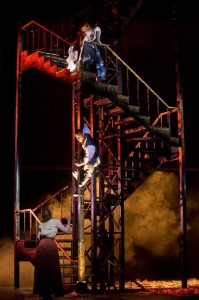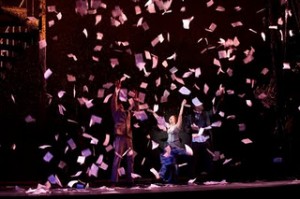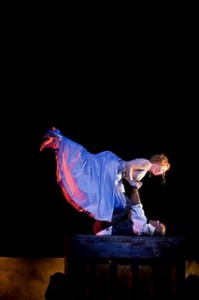 Boston University had a lot of faith in Ellie Heyman’s surrealist interpretation of Hedda Gabler, mounting it on the BU main stage instead of in a standard CFA space like any other masters thesis project. As such, Ibsen’s remarkable text about a caged, trapped woman appeared on an enormous proscenium, played out to hundreds of seats. Everything became big- the performances, the sound design, the direction, even the costumes. Big. When the only thing that should be big about Hedda Gabler is Hedda’s presence in her limited space. A hugely ambitious production, CFA’s Hedda Gabler was an interesting interpretation of something, but it wasn’t Hedda Gabler.
Boston University had a lot of faith in Ellie Heyman’s surrealist interpretation of Hedda Gabler, mounting it on the BU main stage instead of in a standard CFA space like any other masters thesis project. As such, Ibsen’s remarkable text about a caged, trapped woman appeared on an enormous proscenium, played out to hundreds of seats. Everything became big- the performances, the sound design, the direction, even the costumes. Big. When the only thing that should be big about Hedda Gabler is Hedda’s presence in her limited space. A hugely ambitious production, CFA’s Hedda Gabler was an interesting interpretation of something, but it wasn’t Hedda Gabler.
 From Hedda’s Cinderella ball gown to the ceiling-high winding staircase to the pianos that moved about the stage in a senseless motif- literally bearing the actors in a sort of clumsy dance driven by masked figures called the “Shadow Ensemble”- every artistic decision in the play seemed to condescend to the text instead of elevating, enlightening or showcasing it.
From Hedda’s Cinderella ball gown to the ceiling-high winding staircase to the pianos that moved about the stage in a senseless motif- literally bearing the actors in a sort of clumsy dance driven by masked figures called the “Shadow Ensemble”- every artistic decision in the play seemed to condescend to the text instead of elevating, enlightening or showcasing it.
Though Heyman has invested most of her 3 years at BU on Hedda, her production made it seem as though she disliked the text- covering up the words and story with heavy handed “moments” instead of playing the moments that are already there.
The characters too, seemed to disappear somewhat behind larger points that were trying to be made out of nothing.
Eilert Lovborg, specifically, was completely unrecognizable as an animalistic id (played with impressive athleticism by a misguided but compelling Hampton Fluker).
Mrs. Elvsted fared a little better, played with some dexterity by Lily Narbonne, though much of the character’s depth was hidden behind a bundle of nerves.
 Sam Tilles proved an interesting George Tesman in the sense that he was wonderfully endearing despite that being not at all the point of George Tesman.
Sam Tilles proved an interesting George Tesman in the sense that he was wonderfully endearing despite that being not at all the point of George Tesman.
Mathias Goldstein provided a bright spot as the always entertaining Judge Brack and sharing the stage with him brought out the most interesting thing about Alex Highsmith’s title character (a performance that, while energetic and committed, lacked the power, restlessness and control of a great Hedda) . There is really no reason her chemistry with the judge should be easily the most palpable, but it was somewhat interesting that it was. With a Tesman entirely more worthy of her love than is usual and an Eilert who’s more symbol than character, a Hedda who is most engaging when with the judge could have an interesting effect.
 Alas, nothing was made of that. Nothing was made of most interesting things on a character or story level. If the actors were able to carve out a small human moment, it was by chance or sheer rebellion that it managed to be seen. Instead, statements were made with obnoxious sound cues or over-directed staging.
Alas, nothing was made of that. Nothing was made of most interesting things on a character or story level. If the actors were able to carve out a small human moment, it was by chance or sheer rebellion that it managed to be seen. Instead, statements were made with obnoxious sound cues or over-directed staging.
The set was beautiful (designed by Caitlin Fergus) and Ameera Ali’s costumes (other than that horrible ball gown) were excellent (particularly Hedda’s stunning all-black ensemble) but you can’t stage an effective play without bothering to tell the story.
I appreciate a director’s right to interpret, to try something new, to attempt a strange metaphor that not a soul will understand. But those things should serve the play, not ignore it. Henrik Ibsen is the world’s second most produced playwright (after Shakespeare) and is considered the father of modern drama. His work should be played with, not against.
